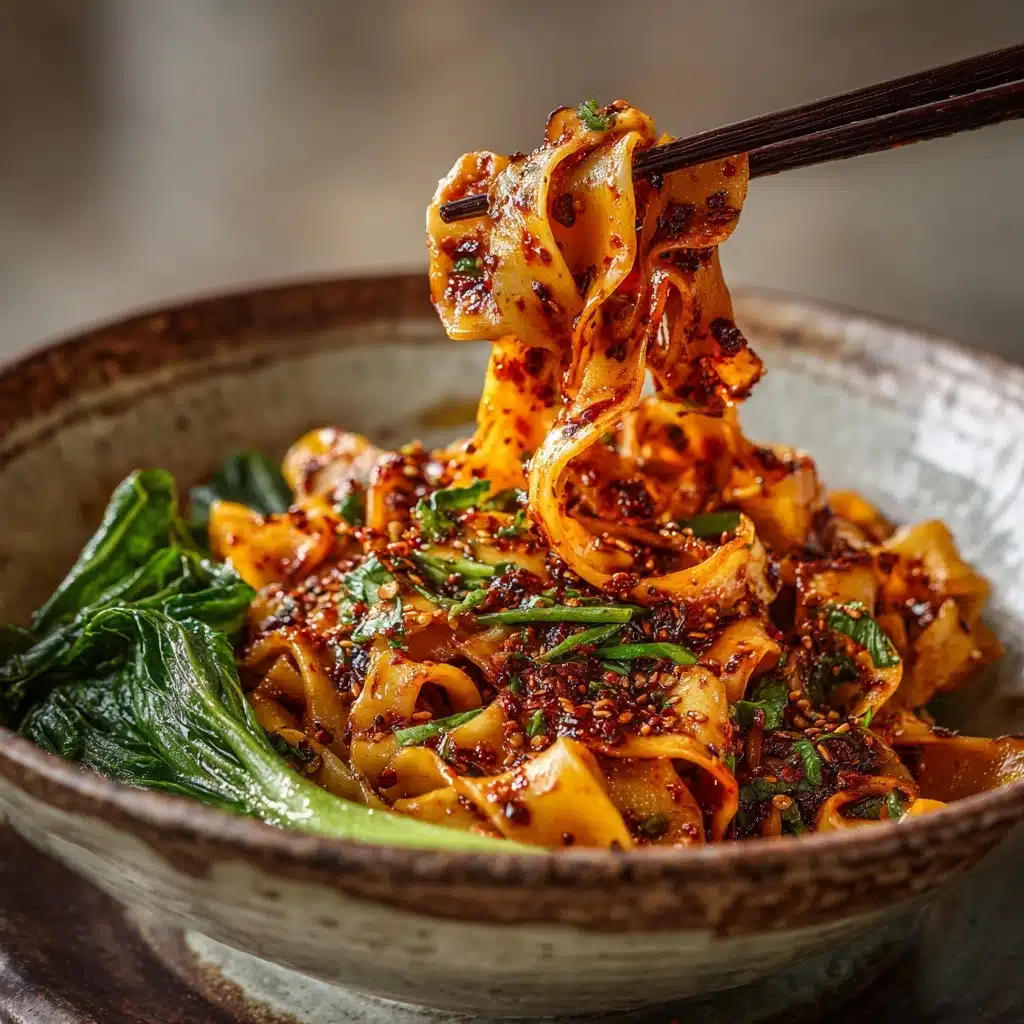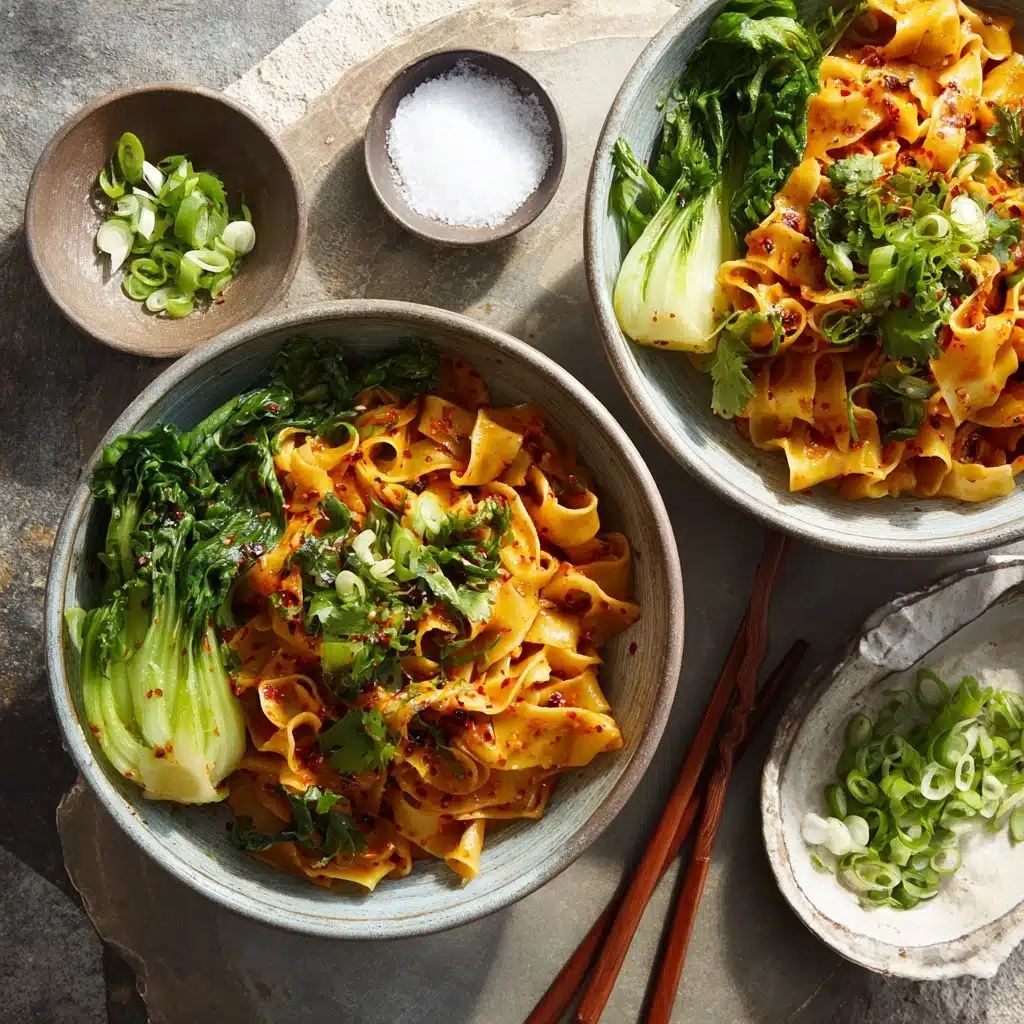Biang Biang Noodles (Yu Po Mian) Recipe
Get ready to dive into a bowl of pure comfort and bold flavors with Biang Biang Noodles (Yu Po Mian)! This fiery, tangy classic from China’s Shaanxi region is famous for its chewy, hand-pulled noodles, refreshingly simple tomato sauce, and irresistible chili oil. Each strand soaks up a medley of aromatics, sweet-tart tomatoes, garlic, and a hint of numbing Sichuan peppercorn, making every bite a symphony of soulful tastes and textures. If you’re craving a dish that’s as fun to make as it is to eat, Biang Biang Noodles (Yu Po Mian) will quickly become your new weeknight obsession.

Ingredients You’ll Need
The magic of Biang Biang Noodles (Yu Po Mian) lies in its humble yet highly effective combination of pantry staples and fresh flavor boosters. Each ingredient plays a crucial role in crafting the rich layers of flavor, springy noodles, and eye-catching colors that make this dish so memorable.
- Peanut oil (or vegetable oil): Provides a silky base for both the sauce and chili oil, adding a subtle nutty aroma.
- Tomatoes, diced: Bring fresh, juicy acidity that balances the spices and adds natural sweetness to the sauce.
- Pinch of salt: Enhances each element, helping the tomato flavor shine.
- Tomato paste: Deepens the sauce’s color and packs in concentrated umami.
- Light soy sauce: Delivers essential saltiness and rich, savory notes.
- Chinkiang vinegar: Offers a gentle tang and malty complexity, key to authentic Shaanxi taste.
- Dark soy sauce (optional): Adds beautifully deep color and subtle sweetness—try it if you like a darker sauce.
- Sugar: Rounds out the acidity of the tomatoes and vinegar for a more balanced flavor.
- Sesame oil: Infuses the sauce with a luxurious, toasty fragrance.
- Green onion (white part minced, green sliced for garnish): Layers in aromatic sharpness and a lovely pop of freshness.
- Garlic, grated: Brings robust, punchy flavor that melds seamlessly with the chili oil.
- Chinese chili flakes: Lend that signature crimson color and tingling heat—adjust to your spice tolerance.
- Toasted white sesame seeds: Offer nuttiness and gentle crunch.
- Cumin powder: A wise little pinch gives earthy warmth that sets this chili oil apart.
- Ground Sichuan peppercorn (optional but highly recommended): Provides the trademark tingly-numb sensation—absolutely worth including for an authentic experience!
- Peanut oil (or vegetable oil), again: Used for creating that epic, fragrant chili oil pour-over.
- Dried knife shaved noodles (or fresh wide noodles or hand-pulled noodles): The chewy, hearty base—go for the widest you can find, or hand-pull for the real entertainment.
- Baby bok choy, tough ends removed and cut into large pieces: Adds a crisp, mild bitterness that balances the spice.
- Chopped cilantro (optional): Provides a final top note of herby freshness and vivid green color.
How to Make Biang Biang Noodles (Yu Po Mian)
Step 1: Make the Tomato Sauce
Start by heating a tablespoon of peanut oil in a medium skillet over medium heat. Toss in the diced tomatoes and a pinch of salt, then cook them down, stirring and gently smashing, until they’re saucy and pulpy—about 4 to 5 minutes. If things dry up, add a splash of water. Stir in the tomato paste and keep cooking for another minute, mixing well so the flavors meld. Turn off the heat, scrape the sauce into a bowl, and set it aside for later. This tangy tomato base is one of the things that makes Biang Biang Noodles (Yu Po Mian) so craveable.
Step 2: Prepare the Sauce Mixture
In a large bowl (big enough to toss all those glorious noodles), whisk together the light soy sauce, Chinkiang vinegar, sesame oil, and sugar, stirring until the sugar dissolves. This is your savory-tangy sauce that will soak right into the hot noodles for maximum flavor. If you’re using dark soy sauce, add it now for extra depth and color.
Step 3: Blanch the Bok Choy
Bring a large pot of water to a rolling boil, then toss in the baby bok choy. Blanch for about 2 minutes, just until the leaves soften and turn vibrant green. Scoop them out with tongs or a slotted spoon and set aside—they’ll add crunch, color, and a hint of bitterness that pairs perfectly with the spicy, savory noodles.
Step 4: Cook the Noodles
Using the same boiling water, cook your wide noodles of choice according to their package directions. If you’re lucky enough to have fresh or hand-pulled noodles, you’ll be able to taste the difference—so chewy and satisfying! Once cooked, rinse the noodles quickly under cool tap water to stop them from overcooking, then drain thoroughly and add them straight into your sauce bowl. Gently toss until every ribbon is coated and glossy.
Step 5: Layer on the Aromatics and Spices
Time to build those signature Biang Biang Noodles (Yu Po Mian) flavors. Sprinkle the minced white part of the green onion, grated garlic, chili flakes, toasted sesame seeds, cumin powder, and (if you’re using it) Sichuan peppercorn directly onto the noodles. This “dry topping” is where the real magic begins and ensures a powerful, aromatic punch with every bite.
Step 6: Pour Over the Hot Oil
In a small saucepan, heat the remaining peanut oil over medium until shimmering and just starting to smoke—not too long or it’ll burn! Swiftly pour the hot oil over the aromatics piled on your noodles. Listen to that sizzle as the oil unlocks incredible fragrance from the garlic and spices. Stir immediately to evenly distribute the flavors while the oil is still hot.
Step 7: Mix in the Tomato Sauce
Add the cooked tomato sauce to the noodle bowl and toss everything together once more. This brings tang, richness, and a gorgeous sheen to your Biang Biang Noodles (Yu Po Mian). Make sure each noodle strand is generously coated for a harmonious, balanced flavor.
Step 8: Garnish and Serve
Nestle the blanched bok choy over the noodles, scatter with sliced green tops of the green onion, and finish with chopped cilantro if you wish. Serve immediately while everything’s piping hot, and get ready for a flavor adventure!
How to Serve Biang Biang Noodles (Yu Po Mian)

Garnishes
Fresh and punchy toppings are the finishing touches that elevate Biang Biang Noodles (Yu Po Mian) from great to iconic. Try a shower of green onions, a handful of cilantro, and even extra sesame seeds if you want more crunch and nuttiness. If you’re a chili lover, a little extra chili oil never hurts!
Side Dishes
Although Biang Biang Noodles (Yu Po Mian) could easily be a meal on its own, it pairs beautifully with cooling sides like smashed cucumber salad, quick pickled radishes, or simple stir-fried greens. The contrast of crisp, refreshing sides makes the rich, spicy noodles shine all the more brightly.
Creative Ways to Present
For a fun twist, serve the noodles family-style on a large platter in the center of the table and let everyone dig in. If you’ve hand-pulled your own noodles, show off those dramatic wide ribbons! Try serving in deep, rustic bowls with all the toppings on the side—let guests mix and match to their flavor preference for an interactive meal.
Make Ahead and Storage
Storing Leftovers
If you’re lucky enough to have leftovers, store the noodles and sauce in an airtight container in the fridge for up to 2 days. The flavors will mingle and deepen overnight, giving you a more concentrated hit of savory, tangy goodness the next day.
Freezing
While fresh Biang Biang Noodles (Yu Po Mian) are best enjoyed right away, you can freeze just the sauce and chili oil if you want to prep ahead. Place them in small containers, thaw, and whip up a fresh batch of noodles whenever a craving strikes.
Reheating
To bring noodles back to life, add a splash of hot water and give them a quick toss in a hot pan or microwave, just until warmed through. Top with a little extra fresh chili oil or green onions to refresh the flavors.
FAQs
Can I use store-bought chili oil instead of making my own?
Absolutely! While freshly prepared hot oil adds amazing aroma and sizzle to Biang Biang Noodles (Yu Po Mian), a good-quality store-bought chili oil is a handy shortcut and works just fine in a pinch.
What can I substitute for Chinkiang vinegar?
If you don’t have Chinkiang vinegar on hand, a mix of balsamic vinegar and a dash of rice vinegar will give you a similar mild tang and depth. White vinegar can be too harsh, so avoid using it if possible.
Can I make this completely vegetarian or vegan?
Biang Biang Noodles (Yu Po Mian) are naturally vegetarian and can easily be made vegan by ensuring your noodles contain no egg (most hand-pulled or knife-cut noodles are vegan by default). Check your soy sauce labels just to be sure.
Do I really need the Sichuan peppercorn?
It’s optional, but highly recommended if you want the authentic lip-tingling sensation that sets Shaanxi noodles apart. If you’re new to it, start with just a pinch and adjust to taste!
Are Biang Biang Noodles (Yu Po Mian) spicy?
The classic recipe is delightfully spicy, but the heat level is entirely up to you. Use fewer chili flakes for a gentler warmth, or pile them on if you love serious heat. The recipe is flexible enough for everyone’s preferences.
Final Thoughts
Whether you’re tangled up in the wide ribbons of homemade noodles or just spooning over that fragrant chili oil, Biang Biang Noodles (Yu Po Mian) are one of those dishes that always make dinner feel special. Try them once, and you’ll see why this street food classic is beloved around the world. Enjoy every slurp!
PrintBiang Biang Noodles (Yu Po Mian) Recipe
These Biang Biang Noodles, also known as Yu Po Mian, are a spicy and flavorful dish featuring wide hand-pulled noodles tossed in a savory and tangy tomato-based sauce. The noodles are topped with fragrant seasonings and fresh vegetables, making it a satisfying meal full of bold flavors.
- Prep Time: 15 minutes
- Cook Time: 20 minutes
- Total Time: 35 minutes
- Yield: 4 servings
- Category: Main Course
- Method: Stovetop
- Cuisine: Chinese
- Diet: Vegetarian
Ingredients
Noodles:
2 bundles (150 g) dried knife-shaved noodles or 400 g fresh wide noodles or hand-pulled noodles
Tomato Sauce:
1 tablespoon peanut oil, 2 tomatoes (diced), pinch of salt, 1 tablespoon tomato paste, 1 tablespoon light soy sauce, 1 tablespoon Chinkiang vinegar, 1/4 teaspoon dark soy sauce (optional), 1 teaspoon sugar, 1 teaspoon sesame oil
Seasonings:
1 green onion (white part minced, green part sliced for garnish), 3 cloves garlic (grated), 1 tablespoon Chinese chili flakes, 1 tablespoon toasted white sesame seeds, 1/4 teaspoon cumin powder, 1/4 teaspoon ground Sichuan peppercorn (optional but recommended)
Other:
3 tablespoons peanut oil, 4 heads baby bok choy (tough ends removed and cut into large bite-size pieces), chopped cilantro for garnish (optional)
Instructions
- Make tomato sauce: Heat 1 tablespoon of oil in a skillet over medium heat. Add tomatoes and salt, cook until broken down. Add tomato paste and stir for 1 minute. Set aside.
- Assemble noodles: Mix soy sauce, vinegar, sesame oil, and sugar in a bowl. Blanch bok choy in boiling water, then cool. Boil noodles, rinse, and drain. Toss noodles in soy sauce mixture.
- Add green onion, garlic, chili flakes, sesame seeds, cumin, and Sichuan peppercorn to noodles.
- Heat oil in a saucepan, then pour over noodles. Mix well. Add tomato sauce. Garnish with bok choy and cilantro. Serve.
Notes
- You can adjust the spice level by increasing or decreasing the amount of chili flakes.
- For a vegetarian version, use vegetable oil instead of peanut oil.
- Feel free to customize the toppings with your favorite vegetables or proteins.
Nutrition
- Serving Size: 1 serving
- Calories: 410
- Sugar: 7g
- Sodium: 580mg
- Fat: 19g
- Saturated Fat: 3g
- Unsaturated Fat: 14g
- Trans Fat: 0g
- Carbohydrates: 49g
- Fiber: 5g
- Protein: 12g
- Cholesterol: 0mg
Keywords: Biang Biang Noodles, Yu Po Mian, Hand-Pulled Noodles, Chinese Noodles, Spicy Noodles








